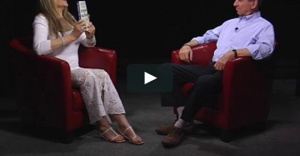 It’s consciousness that rules.
It’s consciousness that rules.
That’s the message we get from worldwide spiritual wisdom and what’s emerging more in quantum physics as well. It’s really consciousness that rules, not matter. If we’re trying to heal the body without healing the mind, using the mind to heal the body, we missed the basic healing that’s necessary for us.
But when we recognize that consciousness is the issue, we take that healing power back and find our true self in the process, then and only then is when the body just naturally heals in response to that. Dr. Henry Grayson’s book “Use Your Body to Heal Your Mind”. https://vimeo.com/41534256
What you resist persists. So simply glossing over a valid fear and concern with the Pollyanna attitude is not going to accomplish anything… “Focusing on the good isn’t just about overcoming our inner grump to see the glass half full.
It’s about opening our minds to the ideas and opportunities that will help us be more productive, effective, and successful at work and in life.”
“We have all heard the usual examples: That Michael Jordan cut from his high school basketball team, Walt Disney fired by a newspaper editor for not being creative enough, the Beatles turned away by a record executive who told them that “guitar groups are on their way out.”
In fact, many of their winning mantras essentially describe the notion of falling up: “I’ve failed over and over again in my life,” MJ said, “and that is why I succeed.” Robert F. Kennedy said much the same: “Only those who dare to fail greatly can ever achieve greatly.” And Thomas Edison, too, once claimed that he had failed his way to success.”
Shawn Achor: The happy secret to better work | TED Talk Watch video · We believe we should work hard in order to be happy, but could we be thinking about things backwards? In this fast-moving and very funny talk, psychologist Shawn Achor argues that, actually, happiness inspires us to be more productive.
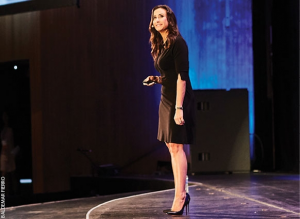 Born to entrepreneurial parents, Kim Perell grew up listening to. . . discussions about growth strategies and smart budget cuts at the family dinner table in Portland, Oregon. Now the 40-year-old serial entrepreneur shares a home in San Diego with her husband and their 3-year-old fraternal twins, yet a new tropical getaway is always on the horizon.
Born to entrepreneurial parents, Kim Perell grew up listening to. . . discussions about growth strategies and smart budget cuts at the family dinner table in Portland, Oregon. Now the 40-year-old serial entrepreneur shares a home in San Diego with her husband and their 3-year-old fraternal twins, yet a new tropical getaway is always on the horizon.
An avid traveler, Perell is never far from the ocean. Perell has been to more than 70 countries, finding inspiration in the great blue. “I just feel the power,” she says. “It’s a reminder of how life is full of amazing opportunity.”
In some ways, Perell was groomed for the entrepreneurial life. Taught to create her own opportunities, she collected aluminum cans from neighbors to recycle for spending money. Interested in horseback riding, she cleaned stables for seven hours in exchange for a one-hour lesson. She worked at a pizza shop and sold men’s suits to fund a car at 16. As a full-time student at Pepperdine, she worked two jobs at an investment bank and a direct marketing company.
“I prioritized my business and then my personal life, making sure I had adequate time and finances to support both of those needs and be successful.” she says. “You can’t put a price on experience. I love being an entrepreneur. I love ideas. But you have to be realistic and you have to live.”
“If I didn’t believe or wasn’t passionate about it, I just wouldn’t do it,” Perell says. “It wouldn’t be worth the day.” “I prioritized my business and then my personal life, making sure I had adequate time and finances to support both of those needs and be successful.” she says. “You can’t put a price on experience. I love being an entrepreneur. I love ideas. But you have to be realistic and you have to live.”
“You could be a great visionary, but if you don’t pair vision with action, it’s just your head in the clouds,” she says. Watch Video
* * *
Perell is the kind of person you instantly like and respect. She’s both blunt and charismatic, confident and gracious, direct and kind. She knows what she wants, but she doesn’t trample on others to get there—certainly a redeeming leadership quality. But you don’t become the CEO of a massively successful company without making some difficult decisions. She sticks to a simple formula: execution over IQ
* * *
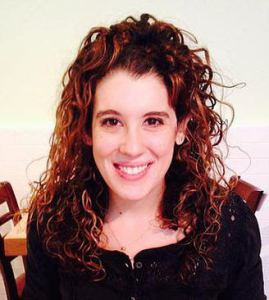 I am a freelance writer, editor, and the former Features Editor of SUCCESS Magazine. I primarily write longform magazine articles, essays and profiles, and have a particular interest in health-related content. My work has appeared in New York Magazine’s The Cut, the Chicago Tribune, Business Insider, Healthline and Racked, among other places.
I am a freelance writer, editor, and the former Features Editor of SUCCESS Magazine. I primarily write longform magazine articles, essays and profiles, and have a particular interest in health-related content. My work has appeared in New York Magazine’s The Cut, the Chicago Tribune, Business Insider, Healthline and Racked, among other places.
I received my master’s degree from the Medill School of Journalism at Northwestern University and my bachelor’s degree from New York University. When I’m not writing or traveling, I can usually be found drinking matcha tea into excess, reading a new book or surfing Anthropologie late into the night.
For Jamie Friedlander who has tried intermittent fasting for 10 days — and I understand why people in Silicon Valley love it… and I recently gained a few pounds due to a shoulder injury that prevented me from participating in my daily barre class, so I wanted to change my eating habits to shed the extra two or three pounds. I came across an article about intermittent fasting, a practice that involves giving up food for certain periods of the day or week.
Intermittent fasting, a diet popular in Silicon Valley, can produce a number of health benefits whether you shed pounds or not. By restricting calorie consumption to a specific time period each day or week (for example, only eating between 12 p.m. to 8 p.m.), you could lose weight, decrease your risk of cancer, reduce blood pressure, and improve blood-sugar control, as Business Insider previously reported. Intermittent fasting is unlike most diets in that it allows you to eat whatever you want, as long as it’s within the consumption period.
Intermittent fasting can take many forms. Some people fast for 24 hours every third or fourth day of the week, according to Healthline. Others opt for the 5:2 diet, meaning they take in a normal amount of calories for five days, then only eat 500 or 600 calories for two days.
Because I am prone to migraines, I worried about choosing a fast that would be too drastic a change from my normal diet. I chose the 16-8 method, where you fast for 16 hours and eat for eight. Here’s what I learned after 10 days of intermittent fasting.
1. It’s normal to be really hungry at first
I decided to do my daily fast from about 8 p.m. until noon the next day. This meant all of my eating for the day occurred between 12 p.m. and 8 p.m. At first, I woke up starving.
I discovered that eating a high-protein snack around 8 p.m., like egg whites or cheese, prevented the hunger pangs that came the following morning, making it significantly easier to fast until noon.
2. I got headaches the first few days, but they slowly went away
Although I (luckily) didn’t have a migraine during the experiment, I did get a handful of dull headaches the first few days, particularly toward the end of my fast around 11 a.m. or noon. After three or four days, my body adjusted to the diet and the headaches dissipated.
3. It’s a good diet if you already skip breakfast
I don’t eat breakfast and never have, which made this form of intermittent fasting fairly easy for me. The stretch from about 10 a.m. to noon was difficult, but I always made it.
I did drink coffee with creamer every morning upon waking up. (Some experts suggest only drinking black coffee when intermittent fasting, though opinions vary, according to Popsugar.) I can go 16 hours without eating, but I definitely can’t write without my usual morning cup of java.
4. The biggest challenge was not being able to eat (or drink) spontaneously
By far, the most difficult part of intermittent fasting for me was the effect it had on my social life. I had to make dinner plans with friends earlier than I typically would and had to pass on a tempting ice cream run with my husband on a 100- degree night in Dallas.
5. When I did splurge on food, I didn’t feel as guilty about it
I have a habit of doing a rough mental count of how many calories I eat each day. I’m not a strict calorie counter, but I always have an idea of how much I’ve eaten, and I try to stay in the 1,600 to 1,800 calorie range. During this experiment, I didn’t worry as much as I normally would about going over 1,800 calories, because I was limiting my hours for eating.
One day I definitely ate more than 1,800 calories. But because I knew I had a fast ahead of me, I didn’t feel as guilty about the cheeseburger, sweet potato fries, and Moscow mules I indulged in.
6. My acid reflux and GERD improved significantly
I have GERD and take a daily medication to prevent acid reflux and heartburn. I forgot to take my medication for a couple of days (a regular occurrence) and noticed that my GERD symptoms – which usually strike late at night – weren’t as severe.
By giving myself three or four hours before bed to properly digest my food, I avoided the reflux that often accompanies rich dinners or late-night snacking.
7. It was nice not having to cut out any foods
I have always avoided specific diets (like the Mediterranean diet or the Atkins diet) because I feared cutting out too many foods. I already eat gluten-free because I have celiac disease, and I didn’t want to give up anything like dairy or meat, too. I enjoyed intermittent fasting because I could still eat everything I wanted to without feeling deprived.
Intermittent fasting is something I’ll continue to do during the week, but not on the weekend
At the end of my 10 days, I lost about two pounds, which was more than I anticipated. I don’t have significant weight loss goals and was primarily looking for a diet that would help me shed a few pounds and then maintain a healthy weight. This diet felt accessible and realistic.
The major downside of the 16/8 method, however, was how prohibitive it was on the weekends. I couldn’t grab drinks with friends or splurge on a late-night chocolate Haagen-Dazs bar with my husband. Moving forward, I plan on partaking in the diet Sunday through Thursday and taking a break on Friday and Saturday.
92% of what we worry about never happens, so why are we so afraid to face our fears? In this episode, Shelby and Josh sit down with SUCCESS associate editor Jamie Friedlander who tried to conquer her fear of public speaking by taking on standup comedy. Plus we reveal our biggest fears and how we faced them head on… or not. And then we take a look at the science behind our most basic instincts of fight or flight in a conversation with Jeff Wise, the author of Extreme Fear: The Science of Your Mind in Danger.
* * *
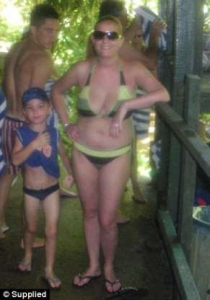 When it comes to the quest to look younger, many women spend thousands of dollars and hours of their time on seeking out the magic cure or potion. But one health and fitness coach says it’s all about the simple things – and taking the time to prioritise your health, fitness and beauty regime.
When it comes to the quest to look younger, many women spend thousands of dollars and hours of their time on seeking out the magic cure or potion. But one health and fitness coach says it’s all about the simple things – and taking the time to prioritise your health, fitness and beauty regime.
Justine Whitchurch, 45, from the Gold Coast, transformed her body and her life in order to shed a huge 17 kilograms at the age of 40, entering her first bikini modelling competition at 41. Since then, she has competed three times. Justine shared her health and beauty secrets exclusively with FEMAIL, and revealed how she took charge of her health to feel better than ever.
For Justine, her health and fitness journey started at the age of 40, when she found herself in the emergency department of the hospital twice and knew she couldn’t go on in such a destructive way: ‘My weight gain came through under-eating, then over-eating, lack of exercise and excessive amounts of alcohol,’ the 45-year-old recalled.
‘I had lost all control, and when I visited the hospital I was told I wouldn’t survive if I continued down this path.’
Justine added that the real turning point came when she looked into her daughter’s eyes and felt scared that she wouldn’t get better for her: ‘That was the cataylst,’ she explained. ‘I didn’t want to die.’ Losing a whopping 24 kilograms in just six months to take her from 71 kilograms to just 47, Justine explained that she quickly lost control of her weight loss.
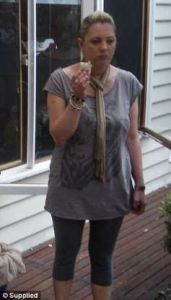 However, when she realised she needed to look after her health as well as her weight loss, that was when things really changed — she worked on getting her current body shape.
However, when she realised she needed to look after her health as well as her weight loss, that was when things really changed — she worked on getting her current body shape.
These days, Justine revealed she has a much healthier and more balanced approach to fitness and diet. A typical week of workouts for the 45-year-old will involve five steady state cardio sessions and five strength sessions.
Justine also shared her day on a plate:
BREAKFAST: Protein oats or almond milk with berries.
MORNING SNACK: A ham or chicken salad wrap.
LUNCH: Chicken, vegetables and rice.
AFTERNOON SNACK: Nut bar and protein shake.
DINNER: Protein with vegetables or a meal made in her slow cooker.
While she has competed in several bikini modelling competitions, she also enjoys regularly training and eating healthy foods. Justine started to compete – and came in 3rd Miss Bikini Australia Musclemania – because she ‘enjoys the discipline of preparation and I wanted to see what I could do to transform my body’.
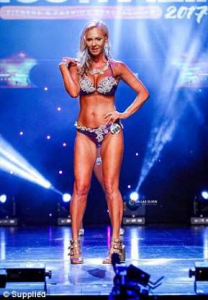 ‘I start with either protein oats, almond milk and berries, a ham or chicken salad wrap for morning tea, chicken, veggies and rice at lunch, a nut bar and protein shake in the afternoon, and then more protein with vegetables for dinner,’ she said. ‘Sometimes a slow cooker meal that the whole family will enjoy is a good option,’ she added.
‘I start with either protein oats, almond milk and berries, a ham or chicken salad wrap for morning tea, chicken, veggies and rice at lunch, a nut bar and protein shake in the afternoon, and then more protein with vegetables for dinner,’ she said. ‘Sometimes a slow cooker meal that the whole family will enjoy is a good option,’ she added.
Speaking about her health and beauty secrets – and how others can take charge of their health, the 45-year-old explained that the first thing she would advise others to remember is that you should ‘never think you’re too far gone to get better’.
Justine Whitchurch’s health secrets
1. Eat plenty of greens.
2. Sleep at least seven or eight hours each night.
3. Drink several litres of water.
4. Moisturise your entire body twice a day.
5. Make an effort with your makeup – it’s worth it.
6. Highlight your cheekbone.
7. Put effort into both your eyebrows and your eyelashes. Women can look a lot older when they don’t maintain these two areas.
8. Eat and eat regularly, but fill your plate with healthy proteins and vegetables.
9. Create a support network and factor in daily exercise to your regime.
10. Use good anti-ageing products.
‘Whether it’s weight gain, age, mental health issues or addiction, there is always an opportunity to start again,’ she said. ‘The first thing you need to do is create a support network that will help you and is positive. Then, establish a routine that sees daily exercise and good nutrition as absolute non-negotiables.
‘Every step you take to better your physical health you will gain even more strength mentally.’ Justine said she is religious but straightforward about her beauty regime.
‘It’s all about looking after yourself from the inside out,’ she said. ‘I make sure I get at least seven or eight hours sleep each night, drink several litres of water and eats lots of greens.’
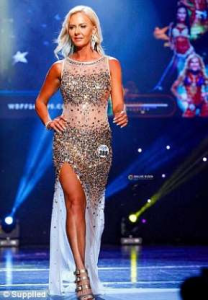 Justine uses anti-ageing skincare constantly’. ‘In terms of makeup, I always wear it. I like to “make an effort” and personally see my mood change more positively when I make an effort. ‘Eyebrows and eyelashes are a big thing for me. I think women can look a lot older when they don’t maintain those two things. And highlight those cheekbones!’.
Justine uses anti-ageing skincare constantly’. ‘In terms of makeup, I always wear it. I like to “make an effort” and personally see my mood change more positively when I make an effort. ‘Eyebrows and eyelashes are a big thing for me. I think women can look a lot older when they don’t maintain those two things. And highlight those cheekbones!’.
Justine said she ‘thrives on routine and being disciplined’. ‘The intensity of my workout sessions will vary depending on how I feel and the level of commitment I have to my work and family at that time. ‘However, my workouts will always get done. Exercise is a priority, it’s my medication and is what keeps me functioning and on top of my game psychology.’
To read or find out more about Justine Whitchurch, visit The Life Factory here.

